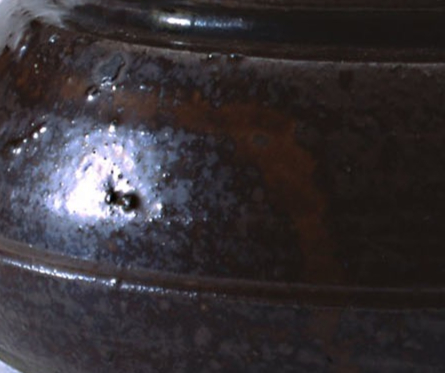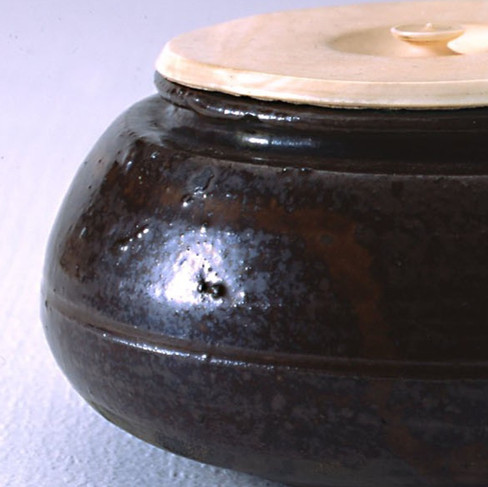茶入筆記 vol.36 本間美術館:唐物大海茶入 - Karamono Chaire, Chinese Taikai Tea Container
- SACA
- Mar 25
- 3 min read

唐物大海茶入
中国・南宋時代
高7.9㎝、口径7.8㎝胴径11.3㎝、底径6.4㎝
本間美術館藏
自室町時代至二戰前的漫長時期當中,茶道具中佔據主導地位的,便是「茶入」(盛裝濃茶的陶製容器)。尤其是鎌倉時代以來自中國傳入的小型陶壺,儘管它們在中國原本的用途迄今仍不甚明確,但傳入日本後卻受到高度珍視,茶人將其稱為「唐物茶入」,並奉為貴重之物。
參考另一間本間美術館所藏唐物大海茶入,銘「凡」:
本件茶入即屬「大海茶入」的器形,口徑寬闊,口緣帶有明顯強烈的外翻捲曲,造型厚實沉穩,壺身上部呈飽滿鼓起狀態,並繞有兩道細緻的凹線作裝飾。整體呈現穩定端莊之器型。
其陶胎(素地)為具黏性質感的茶褐色土料,整體施覆茶褐色釉,間以黑釉交錯其中,使器表呈現豐富多樣的景致變化。底部採用「板起」(用板狀工具整平底部)之製法,並可見有飛濺落下的釉滴痕跡。此外,器物口部延伸至肩部處可見經過修補之痕跡,但絲毫無損其作為唐物大海茶入典型代表作品的地位。本件茶入附有配套的蓋子一枚,以及袋子一件(萌黃地牡丹紋緞子製成)。

室町時代から戦前まで、茶道具の中で、主役の座を占めたのが茶入である。とりわけ鎌倉時代から、中国より請来された小壷は、中国での本来の用途が明らかではないが、日本では唐物茶人と呼ばれて珍重されてきた。
この茶入は大海の形態で、口が大きく、口縁には、強い捻り返しがある。造りは厚く、胴の上部に張りがあり、2本の沈線をめぐらしている。安定した器形である。
素地(きじ)は茶褐色の粘りのある土で、総体に茶褐色の釉(ゆう)がかかり、それに黒釉が交錯し、変化の多い景をなしている。板起こしの底には、飛釉がつく。口から肩に繕いが見られるが、唐物大海茶入を代表する一作である・蓋1枚・袋1つ(萌黄地牡丹文緞子(もえぎじぼたんもんどうんす))が添っている。
名称(事業名) | 唐物大海茶入 |
ふりがな | からものたいかいちゃいれ |
指定区分 | 県指定文化財 工芸品 |
指定年月日 | 昭和28(1953)年 8月 31日 |
所在地(市町村) | 酒田市御成町7-7 |
所有者(実施団体名) | (公財)本間美術館 |
From the Muromachi period up until World War II, chaire (tea containers for thick tea) held a central position among tea utensils. Particularly noteworthy are the small ceramic jars imported from China since the Kamakura period, which—despite their original use in China remaining unclear—have been highly treasured by Japanese tea practitioners, earning the distinguished designation of Karamono chaire (literally, Chinese-imported tea containers).
This particular example belongs to the form known as Taikai (literally "large sea"), characterized by its wide mouth and a prominently turned-out, strongly flared lip. The vessel is thickly potted, displaying a robust, stable form, with a full-bodied upper section decorated by two circumferential incised lines.
The clay body is a tenacious, dark-brown material, entirely covered in a rich brown glaze interspersed with streaks of black glaze, creating a surface marked by dynamic visual variation. The base, flattened by the ita-okoshi method (flattened with a board), shows scattered glaze drips known as tobiyū. Although there is a visible repair running from the lip to the shoulder, this piece remains exemplary of the classic Karamono Taikai Chaire. It is accompanied by a lid and a silk brocade pouch featuring a peony motif set against a pale green ground (moegi-ji botan-mon donsu).

















Comentarios